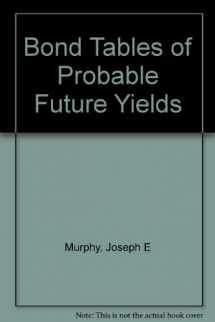
Bond tables of probable future yields
ISBN-13:
9780964629226
ISBN-10:
0964629224
Author:
Joseph E. Murphy
Publication date:
1996
Publisher:
Crossgar Press
Format:
Paperback
452 pages
FREE US shipping
Book details
ISBN-13:
9780964629226
ISBN-10:
0964629224
Author:
Joseph E. Murphy
Publication date:
1996
Publisher:
Crossgar Press
Format:
Paperback
452 pages
Summary
Bond tables of probable future yields (ISBN-13: 9780964629226 and ISBN-10: 0964629224), written by authors
Joseph E. Murphy, was published by Crossgar Press in 1996.
With an overall rating of 3.8 stars, it's a notable title among other
books. You can easily purchase or rent Bond tables of probable future yields (Paperback) from BooksRun,
along with many other new and used
books
and textbooks.
And, if you're looking to sell your copy, our current buyback offer is $0.52.
Description
Bond Tables of Probable Future Yields is designed to aid in the evaluation of interest rate risk. The tables are intended to provide better estimates of interest rate risk than have hitherto been available. The tables do not predict the direction of interest rates; instead they provide probable ranges to which the current yield an a particular maturity bond may rise or fall by a specific date in the future. The tables are arranged by initial yields to maturity. The tables present probabilities for initial yields of from 0.5% to 20% for 15 bond maturities and 35 forecast periods. Each table gives nine probabilities, one for no change in rates, four for declines in rates and four for increases. The tables are based on the fact that the volatility of interest rates is a function of the forecast period, the maturity of the bond and the current level of rates. The evidence for this relationship may be found The Random Character of Interest Rates (Probes, 1990) and in work by M.F.M. Osborne and the author. Six probabilities are given: 50%, 40%, 30%, 20%, 10% and 5%. The level above which yields will probability rise (or fall) is given for each probability. For a 10-year bond when yields are 7%, for example, the probability is 50% that yields will exceed 7%. There is a 20% probability that yields will exceed 9.41%. And there is a 20% probability that yields on the same 7% 10-year bond will drop below 5.21%. The yield figures, though given to two decimal places, are approximate. The tables offer a more precise method of evaluating interest rate risk. For example, if one plans to invest in short bonds in hopes of a rise in rates for later reinvestment in longer issues, the tables provide the probabilities of a potential rise in rates as well as the risks of a decline. The probable future yields also provide information that can be used to calculate future bond prices. If an issuer of bonds decides to wait for a fall in rates, the tables indicate how far rates might fall for a given maturity. The same kind of analysis might be used for buyers or sellers of mortgages. The tables offer a unique approach to evaluating interest rate risk.


We would LOVE it if you could help us and other readers by reviewing the book
Book review

Congratulations! We have received your book review.
{user}
{createdAt}
by {truncated_author}


